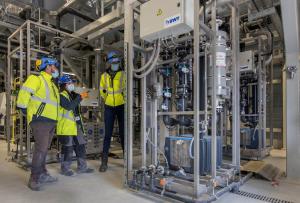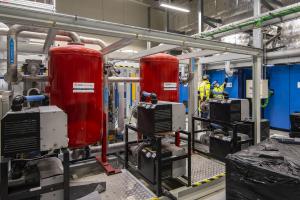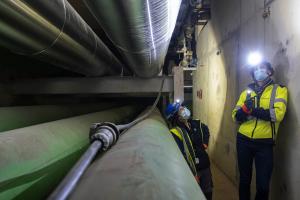Directly from producer to consumer
When fully operational, ITER will be like a large living being with fluids rushing through kilometres of veins and arteries to organs located throughout the installation. By way of pumps, valves and compressors, powerful flows of air, water, helium and nitrogen will be pushed through a ramified network of underground pipes and delivered to a large variety of "clients." In early February, the first connection between producer and consumer was successfully established, delivering compressed air to the cryoplant's hundreds of pneumatic activators.
The main utilities production facility at ITER is the 80-metre-long Site Services Building, located near the Tokamak Complex. Despite its unassuming name, the building will play a strategic role in the daily pulsing and throbbing of the ITER installation. Densely packed with a large variety of equipment—a demineralized water plant, chiller systems, air compressors, dozens of pumps and kilometres of piping—the facility will produce and distribute compressed and breathable air (for operators in ventilated nuclear suits), demineralized water for cooling circuits and detritiation systems, and cold water for air conditioning systems.
Whether liquid of gaseous, the volumes produced will be considerable: the compressed air units for instance can deliver 5,000 cubic metres per hour at a pressure of 10 bar; the production capacity for demineralized water is approximately 34 cubic metres per hour.
The facility hosts systems that produce, chemically treat and send compressed air and gases flowing to clients through the piping network. Hot water is produced in another unit hosting the largest electrical boiler in Europe. Gaseous helium for small consumers such as valves and local testing and inspection systems comes from bottle racks. Gaseous nitrogen extracted from the atmosphere by systems located in the cryoplant will be dedicated to the inerting of glove-boxes and other enclosures, valve actuation, ventilation for tritiated water holding tanks, and ventilation for cooling water system users like drying systems and nitrogen-based pressurizers and valves.
Connecting the compressed air distribution network to the cryoplant was an essential step in the testing of the facility's 1,500 pneumatic actuators and hundreds of control valves. An integrated team composed of ITER operators and European staff from Fusion for Energy and Engage have been working closely together to achieve this milestone. The demineralized water system will be next, and progressively, one by one, all the clients throughout the installation on the platform will be served.




